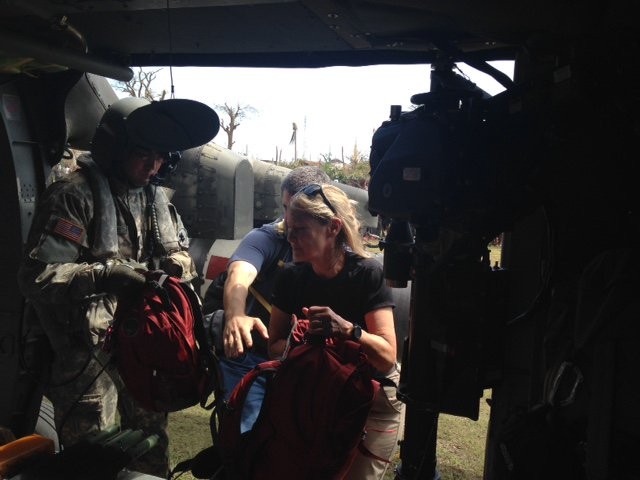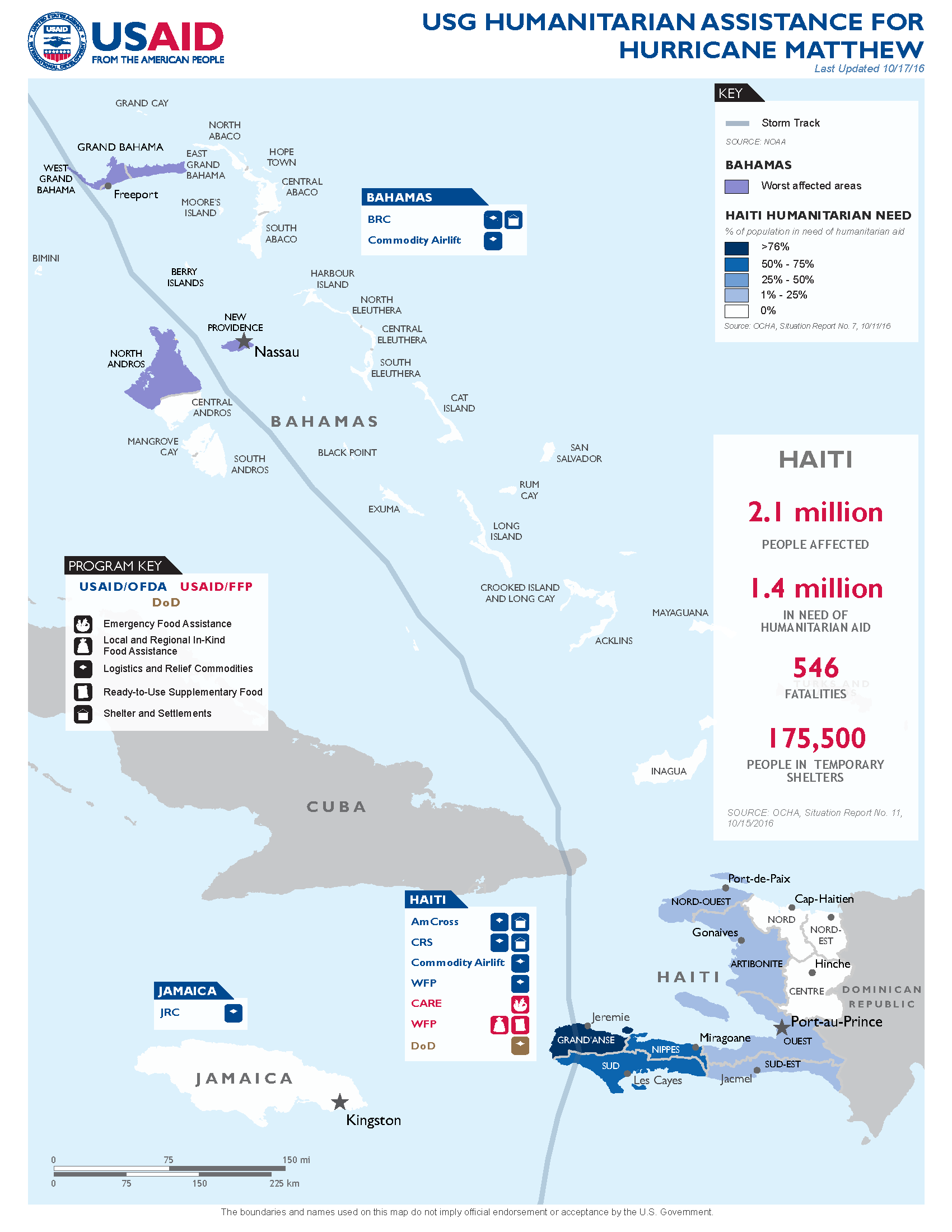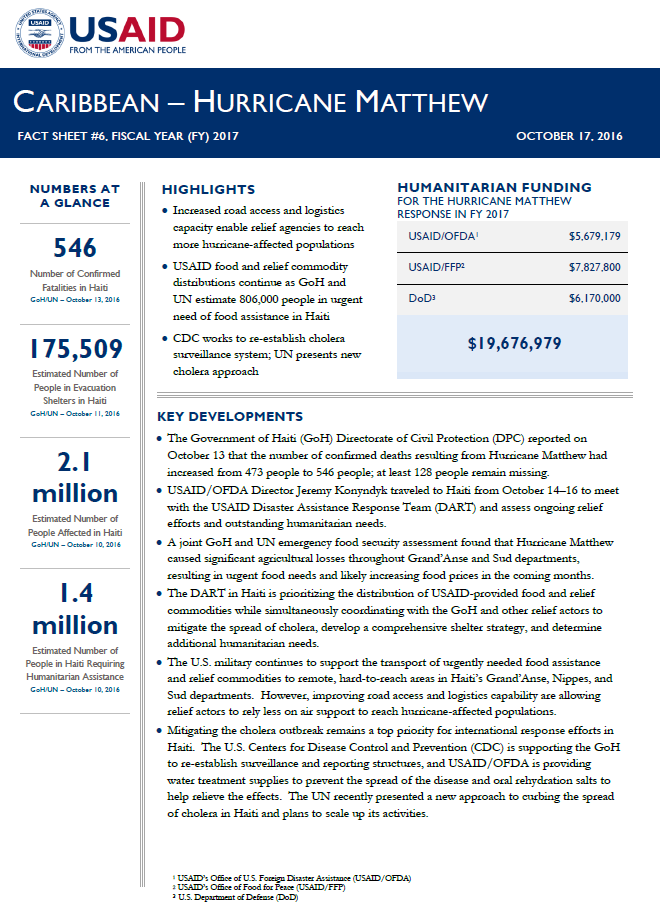
October 17, 2016
Highlights
Increased road access and logistics capacity enable relief agencies to reach more hurricane-affected populations
USAID food and relief commodity distributions continue as GoH and UN estimate 806,000 people in urgent need of food assistance in Haiti
CDC works to re-establish cholera surveillance system; UN presents new cholera approach
Key Developments
Numbers At A Glance
546
175,509
2.1 million
1.4 million
Humanitarian Funding
For the Hurricane Matthew Response
in FY 2017
| USAID/OFDA | $5,679,179 |
| USAID/FFP | $7,827,800 |
| DoD | $6,170,000 |
| TOTAL | $19,676,979 |
The Government of Haiti (GoH) Directorate of Civil Protection (DPC) reported on October 13 that the number of confirmed deaths resulting from Hurricane Matthew had increased from 473 people to 546 people; at least 128 people remain missing.
USAID/OFDA Director Jeremy Konyndyk traveled to Haiti from October 14–16 to meet with the USAID Disaster Assistance Response Team (DART) and assess ongoing relief efforts and outstanding humanitarian needs.
A joint GoH and UN emergency food security assessment found that Hurricane Matthew caused significant agricultural losses throughout Grand’Anse and Sud departments, resulting in urgent food needs and likely increasing food prices in the coming months.
The DART in Haiti is prioritizing the distribution of USAID-provided food and relief commodities while simultaneously coordinating with the GoH and other relief actors to mitigate the spread of cholera, develop a comprehensive shelter strategy, and determine additional humanitarian needs.
The U.S. military continues to support the transport of urgently needed food assistance and relief commodities to remote, hard-to-reach areas in Haiti’s Grand’Anse, Nippes, and Sud departments. However, improving road access and logistics capability are allowing relief actors to rely less on air support to reach hurricane-affected populations.
Mitigating the cholera outbreak remains a top priority for international response efforts in Haiti. The U.S. Centers for Disease Control and Prevention (CDC) is supporting the GoH to re-establish surveillance and reporting structures, and USAID/OFDA is providing water treatment supplies to prevent the spread of the disease and oral rehydration salts to help relieve the effects. The UN recently presented a new approach to curbing the spread of cholera in Haiti and plans to scale up its activities.
HUMANITARIAN ACCESS AND INSECURITY
The GoH and response actors have restored road access along critical corridors in Grand’Anse and Sud, enabling humanitarian organizations to accelerate efforts to reach areas severely affected by the hurricane, including Jeremie commune in Grand’Anse and Les Cayes commune in Sud. As of October 13, USAID/OFDA partner the International Organization for Migration (IOM) had transported approximately 28,500 USAID/OFDA-procured relief commodity kits—comprising two blankets, two pieces of plastic sheeting, one hygiene kit, one kitchen set, as well as a water storage and purification supplies—from Haiti’s capital city of Port-au-Prince to Les Cayes and Jeremie via newly passable roads. The relief supplies are estimated to benefit up to 142,500 people.
Despite improved access along several major transportation routes, some affected areas—particularly those located along secondary and tertiary roads—remain accessible only by boat or helicopter due to continued road blockages, according to the UN and other responders. Efforts remain ongoing to clear blocked roadways.
Under the direction of the DART, the U.S. military has conducted daily relief flights to hard-to-reach areas since October 5 to ensure that populations receive timely distributions of food and emergency relief supplies. As of October 16, DoD reported transporting a total of more than 180 metric tons (MT) of food and nearly 38 MT of non-food items, such as plastic sheeting, water treatment supplies, and hygiene materials, to hurricane-affected populations in inaccessible areas of Grand’Anse, Nippes, and Sud. DoD has received fewer requests for air support in recent days as road access has improved.
The UN and relief agencies have reported multiple security incidents involving humanitarian assistance, including an attack on UN World Food Program (WFP) trucks at the UN Stabilization Mission to Haiti base in Les Cayes. The UN Office for the Coordination of Humanitarian Affairs (OCHA) reports that increased security risks are limiting transport operations to daylight hours and requiring relief agencies to request military escorts for aid deliveries. On October 15, UN Secretary-General (SYG) Ban Ki-moon issued a statement during a visit to Haiti condemning attacks on humanitarian convoys, noting that violence and looting prevent assistance from reaching populations most in need and discourage international aid.
LOGISTICS SUPPORT AND RELIEF COMMODITIES
OCHA reports that significant stocks of relief items are now available in Port-au-Prince, Jeremie, and Les Cayes, as well as in Artibonite Department’s Gonaives commune and Sud-Est Department’s Jacmel commune.
On October 12, the DPC activated a logistics coordination center (LCC) with IOM, USAID/OFDA, and WFP support. The DPC-lead LCC will coordinate all requests for Hurricane Matthew response personnel and relief commodity transportation. WFP has also established logistical hubs in Les Cayes and Jeremie to support the transportation and delivery of food and relief items to hurricane-affected communities. The LCC is formalizing processes to coordinate and transport relief supplies and has launched a website to manage transportation inquiries by response organizations.
USAID partners Agency for Technical Cooperation and Development, CARE, IOM, and WFP have established a coordination unit to facilitate joint relief distributions in Grand’Anse to ensure that households receive food and relief commodities in one package. WFP plans to assign eligible households specific distribution sites and dates to ensure smooth provision of assistance.
As of October 16, USAID/FFP partner CARE had distributed food and water, sanitation, and hygiene (WASH) supplies to an estimated 6,600 households, or approximately 33,000 people, in Grand’Anse’s Moron commune. As of October 11, USAID/OFDA partner IOM had distributed relief supplies to more than 100 households in Grand’Anse and also provided non-governmental organization (NGO) Mission of Hope Haiti with 5,500 USAID/OFDA-supplied, family-sized hygiene kits for distribution in Grand’Anses’s Bonbon and Abricot communes. On October 16, IOM distributed food and relief commodities to an estimated 1,000 people in Jeremie.
In Sud, USAID/OFDA partner Catholic Relief Services (CRS) had distributed food and relief supplies—including blankets, hygiene kits, safe drinking water, and water buckets—to more than 10,000 people across Les Cayes, Port Salut, Roche-a-Bateau, Saint-Jean-du-Sud, and Torbeck communes as of October 13. From October 14–16, CRS reached an additional 2,000 people in Sud’s Arniquet and Torbeck communes with relief supply distributions.
HEALTH AND WASH
Although pre- and post-hurricane epidemiological data remains fragmentary, many communities are reporting increases in suspected cholera cases, according to OCHA. Nonetheless, the extent to which new suspected cases represent actual cholera cases or an increase above baseline levels remains unclear. Health actors caution that reliable data regarding the number of new cholera cases will not become available until surveillance structures and laboratory capacity are restored.
Health actors continue efforts to re-establish cholera surveillance and reporting structures in affected areas. CDC is working with the GoH Ministry of Public Health and Population (MSPP) to reconcile recent reports of suspected cholera cases with data collected by the GoH National Cholera Surveillance System. The GoH MSPP resumed daily reporting of new suspected cholera cases in recent days, although reporting remains incomplete.
CDC response teams are assessing health care and surveillance capacity, as well as WASH needs, in Grand’Anse and Sud. In Jeremie, CDC epidemiologists are working with the GoH MSPP and the Pan American Health Organization (PAHO) to conduct a rapid risk assessment of disease surveillance capacity at health facilities, including cholera treatment centers (CTCs), and in temporary shelters. Preliminary findings indicate limited capacity to detect, confirm, and treat cholera cases in hurricane-affected areas. Of 12 health facilities assessed by Grand’Anse health authorities in recent days, most have not resumed operations due to damaged infrastructure, ongoing power outages, and inadequate supplies of medicines, CDC reports. PAHO estimates that at least 33 of 45 CTCs in Grand’Anse and Sud sustained hurricane-related damage.
On October 14, UN Deputy Secretary-General Jan Eliasson briefed Member States on the UN’s new approach to curbing the spread of cholera in Haiti, particularly amid the increased humanitarian needs and risk of cholera transmission following Hurricane Matthew. The new approach comprises two tracks: 1) strengthening efforts to treat and eliminate the disease and improve long-term access to clean water and sanitation facilities; and 2) developing a framework for assistance to those people most impacted by the 2010 cholera outbreak. During the briefing, the Deputy Secretary-General also reaffirmed the UN’s commitment to long-term solutions that reduce vulnerability and strengthen resilience to the disease.
During his recent visit to Haiti, SYG Ban underscored that the UN is scaling up its activities to contain cholera and ensure access to health and WASH services for all affected populations. SYG Ban called on the international community to provide additional resources in response to the hurricane and the increased risk of cholera.
OCHA reports that 12 organizations are presently engaged in health-related response activities in Grand’Anse, while 25 organizations are conducting health interventions in Sud. Additionally, relief agencies had provided nearly 50 metric tons of medical and WASH supplies to the two departments as of October 14.
USAID/OFDA has provided 5.7 million water purification tablets—sufficient to meet the water treatment needs of approximately 38,000 households, or 190,000 people, for one month—to help prevent the spread of cholera and other water-borne illnesses in hurricane-affected areas. In addition, USAID/OFDA is airlifting a three-month supply of calcium hypochlorite to assist the GoH with treating government-managed water systems countrywide. USAID/OFDA is also providing 1.5 million individual servings of oral rehydration salts to help relieve the effects of cholera and other diarrheal diseases.
DISPLACEMENT, PROTECTION, AND SHELTER
Approximately 175,500 people remain displaced in more than 220 temporary shelters, according to OCHA. Assessments, including those conducted by DART shelter and settlements advisors, remain ongoing to determine the scope of short- and longer-term shelter needs. The DART is coordinating with the GoH and other relief agencies to develop a comprehensive shelter strategy.
According to OCHA, more than 40 percent of the 1.4 million people requiring humanitarian assistance are children—primarily in Grand’Anse and Sud—in need of education, shelter, and child protection services. In addition to distributing shelter commodities and establishing temporary learning centers to avoid prolonged disruption of school services, relief actors are coordinating with the GoH office for child protection, Brigade de la Protection des Mineurs, to strengthen the unit’s presence and capacity in hurricane-affected areas.
FOOD SECURITY AND NUTRITION
An estimated 806,000 people in hurricane-affected areas of Haiti are in urgent need of food assistance, according to a joint GoH, UN Food and Agriculture Organization (FAO), and WFP emergency food security assessment released on October 14. Assessment findings indicate that Hurricane Matthew affected nearly all agriculture in Grand’Anse and resulted in significant crop and livestock losses in Sud, including nearly 80 percent crop loss in Les Cayes and Torbeck. The GoH, FAO, and WFP project a significant increase in commodity prices over the coming three months due to market disruptions and reduced food sources.
As of October 15, USAID partner WFP had delivered emergency food assistance to nearly 43,000 people Grand’Anse and Sud, with additional distributions underway. The UN agency had also transported more than 1,000 MT of food assistance to warehouses in Jeremie and Les Cayes and mobilized 15 off-road vehicles to support distributions as of October 14. Additionally, USAID-supported organizations and DART-coordinated deliveries had supplied food and emergency relief commodities to more than 50,000 people in Grand’Anse, Nord-Ouest, and Sud departments.
To date, USAID/FFP has contributed nearly $7 million to support WFP’s operation to provide urgently needed food assistance to 750,000 people in Haiti for three months and to transport 6,600 boxes of ready-to-use supplementary foods (RUSF) to prevent and treat malnutrition among affected populations. The RUSF is sufficient to provide approximately 495,000 daily supplementary rations to help meet the nutritional needs of young children vulnerable to malnutrition or to treat approximately 13,200 children with moderate acute malnutrition.
USAID/Haiti partner Jhpiego plans to deliver 400 kilograms of USAID/FFP-supplied RUSF sachets—sufficient to treat approximately 60 children with moderation acute malnutrition—to health clinics in Les Cayes and Jeremie on October 17.
OTHER HUMANITARIAN ASSISTANCE
On October 16, the UK Department for International Development (DFID) announced approximately $3.7 million in additional funding, bringing the total DFID contribution to approximately $9.7 million for the Hurricane Matthew response. DFID’s funding will enable NGOs—including Action Aid, CARE, Internews, and the UN Children’s Fund (UNICEF)—to support cholera prevention and treatment activities, as well as provide humanitarian coordination, protection, shelter, telecommunications, and WASH assistance to affected populations.
CONTEXT
Hurricane Matthew made initial landfall near Haiti’s Les Anglais commune, Sud Department, and secondary landfall over eastern Cuba on October 4 before continuing to traverse The Bahamas from October 5–7. The hurricane brought destructive winds, heavy rainfall, and dangerous storm surge, resulting in extensive damage to crops, houses, and infrastructure, as well as widespread flooding in some areas.
On October 2, U.S. Ambassador to Haiti Peter F. Mulrean and U.S. Chargé d’Affaires, a.i., for Jamaica Eric Khant issued disaster declarations in response to the anticipated effects of Hurricane Matthew. U.S. Chargé d’Affaires, a.i., Lisa A. Johnson issued a disaster declaration in response to the anticipated effects of Hurricane Matthew in The Bahamas on October 4.
USAID activated a regional DART on October 3 with staff in The Bahamas, Haiti, and Jamaica. USAID also stood up a Washington, D.C.-based RMT to coordinate the regional humanitarian response.
Based on assessment findings and in consultation with government representatives in the two countries, USAID discontinued DART operations in Jamaica and The Bahamas on October 5 and 13, respectively. USAID/OFDA regional staff will continue to monitor USAID/OFDA assistance provided to the Bahamas Red Cross (BRC) and the Jamaica Red Cross (JRC) to address the immediate needs of populations affected by Hurricane Matthew.









Comment
Make a general inquiry or suggest an improvement.